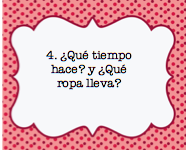It is time to get dressed and have some fun!
My students were asked to design outfits for their new friends. Then depending on their level, we did different activities.
In the past I worked with K-8 and and this is how we approached this topic:
K-3rd?: For each grade level I had designed an appropriate list of vocab words that I know they were able to grasp. We used lots of movement to "put" those items on. In some classes, the students even brought extra clothes to dress up and play some serious rounds of "Simon dice"!
3rd-8th: The older grades were able to talk more about them. So for example they would give them new names, ages, nationalities. They would present their "new" friend to the class. My older groups would also venture into descriptions of the clothing items, tell us where they shop for this items and what their favorite things were. They also partnered up and expressed what items they liked or disliked from the outfit of their partner's new friend. We had a great time!
Currently, I work with high schoolers... this is how we worked this same activity.
High school: My high school students did the same steps as the younger ones but you can always take it a bit further. Currently we are working with pronouns after prepositions as well as stem changing verbs. So, I tried to tie it up together and created some conversation cards that they were able to use in small groups. We did our basic introductions for the "new" friend and then we incorporated weather and seasons and described what we wear in each season.
 We also worked with descriptions and adjective agreement by using colors and textures as adjectives. In order to keep "old" material fresh, we also went shopping. Images of clothing items were posted around the room with different price tags. They were each given a budget and asked to shop around. Then we gathered and volunteers could share what they purchased.
We also worked with descriptions and adjective agreement by using colors and textures as adjectives. In order to keep "old" material fresh, we also went shopping. Images of clothing items were posted around the room with different price tags. They were each given a budget and asked to shop around. Then we gathered and volunteers could share what they purchased.
For homework, students had to address the different conversation cards in writing so we could focus on form and spelling.
Overall the students in all grade levels were very responsible to the activity and enjoyed creating their own materials.
One fun game that you can create after students have present their friends, is a game of guess who. You can draw 5 random ones and display them on the board. Then read aloud some clues about those cards and have the students guess which friend those clues refer to. They can play individually or in small teams. Get ready for some intense competition =D
One fun game that you can create after students have present their friends, is a game of guess who. You can draw 5 random ones and display them on the board. Then read aloud some clues about those cards and have the students guess which friend those clues refer to. They can play individually or in small teams. Get ready for some intense competition =D
You can download the whole pack here. It will include the pronoun after preposition lesson; the characters to color; the conversation cards (12total) and the answer sheet.
















